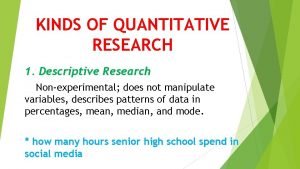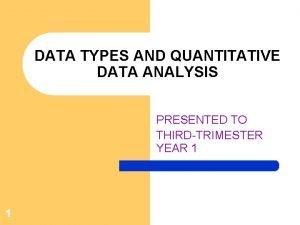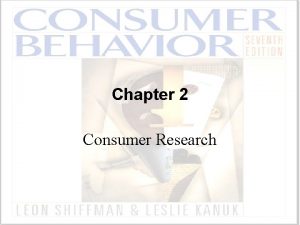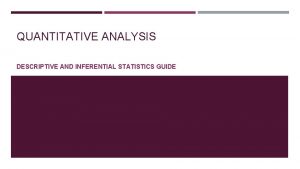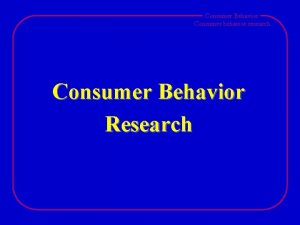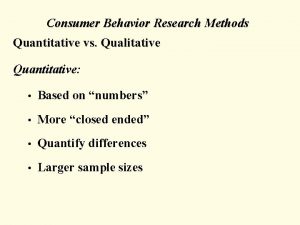Chapter 2 Consumer Research Quantitative Research Descriptive in

























- Slides: 25

Chapter 2 Consumer Research

Quantitative Research �Descriptive in nature. �Enables marketers to “predict” consumer behaviour. �Research methods include experiments, survey techniques, and observation. �Findings are descriptive, empirical and generalizable.

Qualitative Research �Consists of depth interviews, focus groups, metaphor analysis, collage research, and projective techniques. �Administered by highly trained interviewer-analysts. �Findings tend to be subjective. �Small sample sizes

The Consumer Research Process �Six steps �defining the objectives of the research �collecting and evaluating secondary data �designing a primary research study �collecting primary data �analyzing the data �preparing a report on the findings


Developing Research Objectives �Defining purposes and objectives helps ensure an appropriate research design. �A statement of objectives helps to define the type and level of information needed.

Secondary Versus Primary Data �Secondary data: data that has been collected for reasons other than the specific research project at hand �Primary data: data collected by the researcher for the purpose of meeting specific objectives

Major Sources of Secondary Data Government Publications Periodicals & Books Internal Sources Commercial Data

Data Collection Methods Observation Experimentation Surveys

Observational Research �Helps marketers gain an in-depth understanding of the relationship between people and products by watching them buying and using products. �Helps researchers gain a better understanding of what the product symbolizes. �Widely used by interpretivist researchers.

Experimentation �Can be used to test the relative sales appeal of many types of variables. �Only one variable is manipulated at a time, keeping other elements constant. �Can be conducted in laboratories or in the field.

Survey Data Collection Methods Personal Interview Mail Telephone Online

Validity The degree to which a measurement instrument accurately reflects what it is designed to measure Reliability The degree to which a measurement instrument is consistent in what it measures

Attitude Scales �Likert scales: easy for researchers to prepare and interpret, and simple for consumers to answer. �Semantic differential scales: relatively easy to construct and administer. �Rank-order scales: subjects rank items in order of preference in terms of some criteria

Example of a Likert Scale Please place the number that best indicates how strongly you agree or disagree with each of the following statements about shopping online in the space to the left of the statement. 1 = Agree Strongly 2 = Agree 3 = Neither Agree or Disagree 4 = Disagree 5 = Disagree Strongly _____ a. It is fun to shop online. _____ b. Products often cost more online. _____ c. It is a good way to find out about new products.

Excellent Neutral Poor Semantic Differential Profiles of Three Pay -Per-Movie Services

Rank-Order Scales Rank the following computer manufacturers in terms of hotline help by placing a 1 next to the one who provides the best telephone help, a 2 next to the second best, until you have ranked all six. _____ IBM _____ Dell _____ Compaq _____Hewlett Packard _____ Gateway _____ NEC

Qualitative Data Collection Methods Depth Interviews Projective Techniques Focus Groups Metaphor Analysis

Focus Group A qualitative research method in which eight to ten persons participate in an unstructured group interview about a product or service concept

Projective Techniques Research procedures designed to identify consumers’ subconscious feelings and motivations.

Metaphor Analysis � The use of one form of expression to describe or represent feelings about another is called a metaphor. � Based on belief that metaphors are the most basic method of thought and communication. � Zaltman Metaphor Elicitation Technique (ZMET)- first patented and used in US �combines collage research and metaphor analysis �to bring to the surface the mental models and the major themes or constructs that drive consumer thinking and behaviour.

Customer Satisfaction Data Collection Instruments �Customer Satisfaction Surveys �Gap Analysis of Expectations versus Experience �Mystery Shoppers �Customer Complaint Analysis �Analysis of Customer Defections- to customers leave the company? analyse why

Sampling Plan Decisions Whom to survey? How many? How to select them?

Probability Sampling Designs Simple random sample Systematic random sample Every member of the population has a known and equal chance of being selected. A member of the population is selected at random and then every “nth” person is selected. Stratified random sample The population is divided into mutually exclusive groups (such as age groups), and random samples are drawn from each group. Cluster (area) sample The population is divided into mutually exclusive groups (such as blocks), and the researcher draws a sample of the groups to interview.

Non-Probability Sampling Designs Convenience sample The researcher selects the most accessible population members from whom to obtain information (e. g. , students in a classroom) Judgment sample The researcher uses his or her judgment to select population members who are good sources for accurate information (e. g. , experts in the relevant field of study). Quota sample The researcher interviews a prescribed number of people in each of several categories (e. g. , 50 men and 5 women).
 Food webs
Food webs Descriptive correlational research design
Descriptive correlational research design Descriptive method
Descriptive method Why use descriptive correlational design
Why use descriptive correlational design Different kinds of quantitative research
Different kinds of quantitative research Consumer behaviour research process
Consumer behaviour research process Primary consumer vs secondary consumer
Primary consumer vs secondary consumer Consumer diversity in consumer behaviour
Consumer diversity in consumer behaviour Characteristics of consumer behaviour
Characteristics of consumer behaviour Consumer markets and consumer buyer behavior
Consumer markets and consumer buyer behavior What is research instrument
What is research instrument Chapter 2 quantitative research
Chapter 2 quantitative research Qualitative research has holistic nature
Qualitative research has holistic nature Is interviews qualitative or quantitative
Is interviews qualitative or quantitative Sampling methods in qualitative and quantitative research
Sampling methods in qualitative and quantitative research Appendices sample
Appendices sample Research content example
Research content example Qualitative quantitative
Qualitative quantitative Steps of quantitative research process
Steps of quantitative research process Data types in quantitative research
Data types in quantitative research Key concepts of qualitative research
Key concepts of qualitative research Example of independent variable in quantitative research
Example of independent variable in quantitative research T test quantitative research
T test quantitative research Features of quantitative research
Features of quantitative research Quantitative research about cycling
Quantitative research about cycling Theoretical framework and hypothesis development
Theoretical framework and hypothesis development




